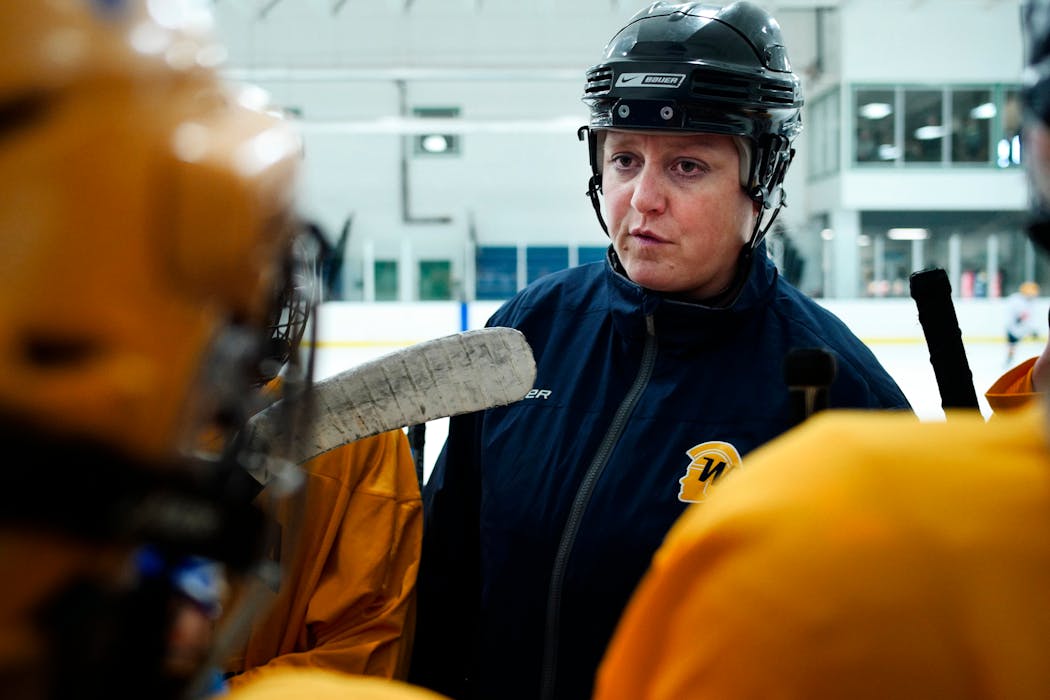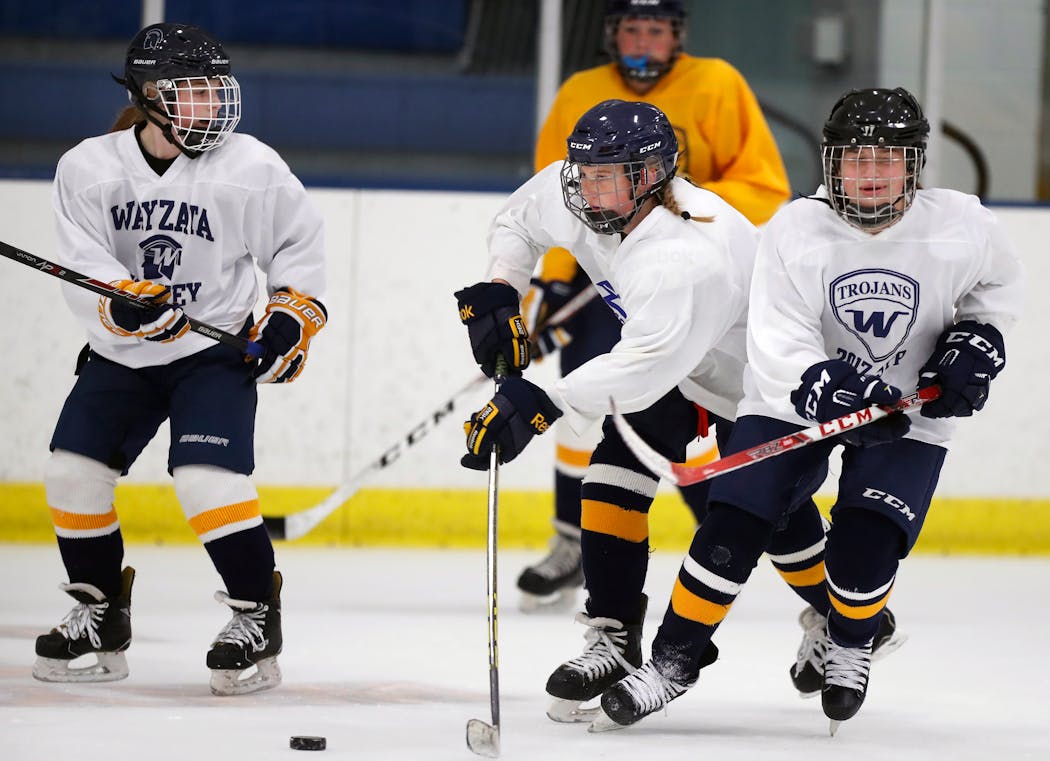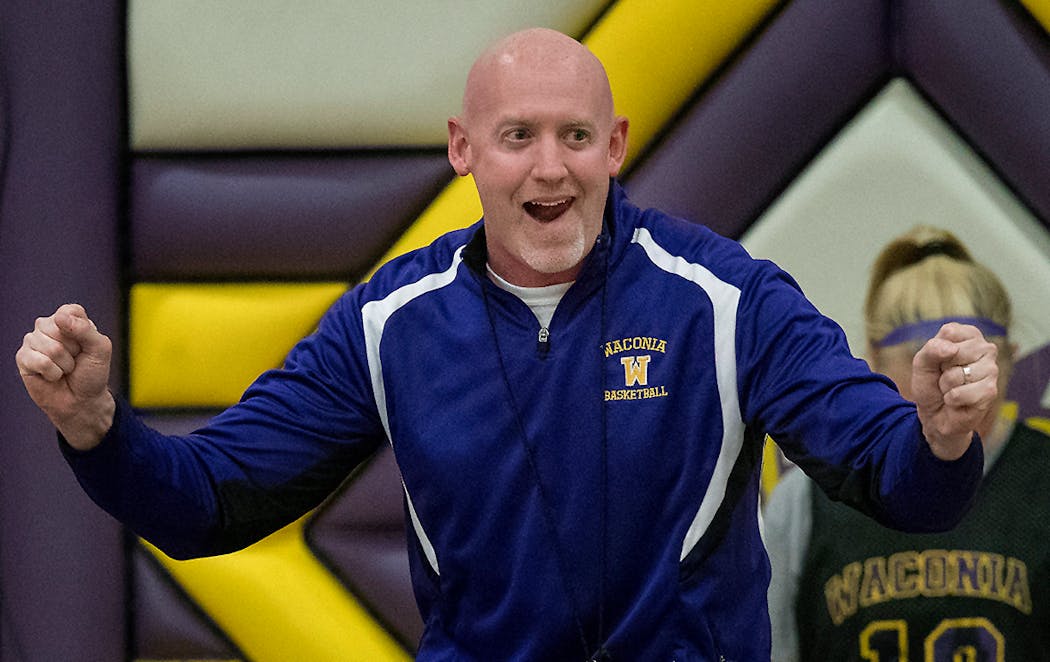The e-mails from angry parents come faster and more often than any time in his 25 years as a high school coach, sometimes waiting for Carl Pierson by the time he arrives home from a game.
Each time it happens, the Waconia girls' basketball coach knows a long night is about to get even longer.
After he enters statistics, uploads and edits game film and creates a scouting report for the next day's practice, Pierson faces a choice: Take the time to carefully craft and send a response, or put it off until morning and endure a lousy night of sleep dreading the thought of hard feelings festering with a parent and their player.
Coaching a varsity team has never been an easy job, but it's become even more challenging amid often-outsized expectations for prep players.
Year-round training of young athletes has raised the skill level and overall quality of Minnesota high school sports. But the proliferation of elite teams, development camps, and club programs also means the high school team may not be the most important one in the eyes of today's high school athletes — or their parents. Nor is Pierson the only coaching voice that his athletes are hearing or trying to listen to.
When expectations aren't met, parents blame the high school coaches — whose work now extends well-beyond a season's start and end — and even push for their ouster.
"There's certainly more of an expectation from parents that their child makes varsity and becomes a starter because they were on an elite or select team and told they were going to be a Division I scholarship player," said Pierson, who has worked in South Dakota, Red Wing and Champlin Park. "They'll say, 'So he or she needs to start, or we're going to go somewhere else.'
“Most players don't have much time for their body to recover with AAU and high school expectations, and then you add personal trainers and workouts. The last two years, our girls have played in the state tournament on Saturday and had AAU practice the very next day.”
"We have to recruit our own kids,'' he said. "That dynamic didn't exist 15 years ago."
Even coaching titans such as Faith Johnson Patterson, who led teams to five girls' basketball state titles at Minneapolis North and three at DeLaSalle, feel the difference.
"Kids are so empowered that it's almost impossible to coach anymore," said Johnson Patterson, who recently left Eden Prairie after two seasons. "Things are controlled so much now financially that kids are misled on what it takes."
While not the only factor that contributes to coaches quitting or retiring, dealing with parents is often cited. Annual turnover ranges from an average of 10 percent in football the past four seasons to 18 percent in girls' hockey the past five. Growing numbers of boys' basketball coaches have departed in the past three seasons, including 71 since 2016-17.
After the ouster of two high-profile boys' hockey coaches — Jeff Pauletti at Roseville and Tony Sarsland at Elk River — Rep. Dean Urdahl authored a bill in 2013 to forbid parental complaints for being the sole reason to not renew a high school coach's contract. The measure was passed into law, but its effects are hard to discern.
Fast-spreading complaints via social media can further stoke tension. In 2016, Tony Scheid resigned as Stillwater girls' hockey coach, saying he and his family had been subjected to "unrelenting and vicious" verbal attacks from a group of parents.
"Parents do have leverage, and that's the biggest concern for high school coaches," said Jessica Christopherson, varsity girls' hockey coach at Wayzata and president of the sport's coaches association. "If there was a problem, parents used to want to sit down with the coach or maybe the athletic director. Now, they call the school board or their legislator.
"Who is going to want to put up with that for $5,000 or $7,000 per year?"
A full-time job
From the time one basketball season ends until the start of the next, Pierson busies himself with everything from coaching varsity hopefuls in June and July to preparing fall tournaments, running youth basketball drills, scheduling transportation for road trips — even working with a printer on team posters.
"About 70 percent of your job is administrative," Pierson said. "The only time that I ever get about two consecutive weeks without any basketball on my brain is usually the first two weeks of August."
High school coaches are adjusting to new realities on their time and energy.
"It used to be intensive from November to March and then it relaxed quite a bit," said Forest Lake boys' basketball coach Dan Cremisino, who began coaching in the early 1980s as an assistant at Columbia Heights, his alma mater. "When my son was a freshman in 2003, he played about 120 games from spring to summer to fall and the high school season. I played about 10 percent of that amount as a freshman. So as a coach, your sport has to be your passion and your hobby. You're probably not going to be fishing and hunting."
Tensions arise
For all the talent they bring out in teen athletes, select teams, national camps, year-round training and sport-specific instruction create unintended consequences.
Players hone their skills year-round, and when the investment doesn't yield desired roles or playing minutes on their school team, conflict is born. The different realities of pay-to-play select or elite teams and varsity teams that players must make can get lost on parents.
"It has become more difficult to keep a player on a team who you do not anticipate will receive significant game minutes," Cremisino said. "It is not a role that a player wants or parents support."
High school coaches are permitted to work with their athletes for much of June and July. But Matt Funk, boys' hockey coach at St. Paul Academy, said many of his players use that time to pursue additional hockey training, sometimes away from their varsity peers. Results vary.
"These guys come back sometimes with bad habits," Funk said. "They want to be high-flying and have no defensive zone responsibility. And when we practice that and hold them accountable, we get the look."
Some camp coaches aren't afraid to voice their perceived superiority. Dickson Jensen, founder of the All Iowa Attack basketball academy, one of 32 Nike Girls Elite Youth sponsored programs, raised hackles in Minnesota last year after he e-mailed players and parents to discourage participation in summer basketball with their high school programs.
"I highly recommend all girls are at Attack first and then high school second,'' Jensen wrote in the e-mail. "You will get better playing with us by being at practices and tournaments. High school summer basketball is a good place to get hurt and create bad habits at times."
Jensen's claims enraged Pierson, executive secretary for the Minnesota girls' basketball coaches association. He said the sport's leadership is "seeing high school sports taking more of a back seat, as something to do between club seasons."
Christopherson said a recent Wayzata graduate told her "the high school season was the offseason'' compared with summer hockey training and showcases.
“Sometimes it feels like the club team is more important to the kid/parent than the [high school] team. … I feel college coaches don't put as much time and effort into relationships with [high school] coaches anymore like they used to. They rely on the club teams/coaches to provide information about the kid. … If kids want to play at the next level, they better play AAU.”
Hard feelings can grow among varsity teammates due to differences in offseason investment.
"There's a resentment that forms between players invested year-round and the others, like, 'You don't care enough,' or 'You don't practice as much as we do,' " said Pierson, who wrote a book called "The Politics of Coaching: A Survival Guide to Keep Coaches From Getting Burned.''
"There's a perceived disparity, an elitism that sometimes forms, that can have a detrimental effect on a varsity team. That became more prevalent about five years ago. I've seen it and I know it's not unique to us."
Those dynamics can leave high school coaches "caught in the middle,'' said Doug Hartmann, a sociology professor at the University of Minnesota who studies sports and their role in society. "When they do get their varsity kids back together, the skill level can be so different that they have to balance creating a championship-type team while including as many kids as they can."
Learning to share
Varsity coaches no longer have exclusive rights to their athletes in season. Some football players compete in hockey's Upper Midwest High School Elite League. Some athletes pull double duty, like the Wayzata baseball players who have worked with pitching-specific coaches during the varsity baseball season.
Bobby DeWitt, who has coached Wayzata for a decade and led them to the 2016 Class 4A state championship, maintains conditioning for his lesser-used pitchers through bullpen sessions consisting of 25 to 30 pitches per workout. Last year, one player passed because he had scheduled a pitching session with his outside coach later than same evening.
"Unfortunately, players and parents are getting connected to these guys before they get to the high school, and our voices as coaches are not always heeded when so much money has already been invested," said DeWitt, who pitched at the University of Minnesota.
DeWitt doesn't hold it against players but nevertheless shuts them down at practice for their own good.
"I'm more worried about safety of their arm than a battle between a high school coach and a private coach," DeWitt said.
Acceptance is evolving among varsity coaches when it comes to sharing athletes. Cremisino said he supported the decision of former basketball player Matt Wallner — a Division I baseball prospect — to schedule hitting and throwing workouts during the season outside of practice and games.
"We never wanted Matt to feel that he could not pursue his baseball career," Cremisino said. "I think as a coach I've learned to accept that I can't say, 'It's basketball or nothing.' "
Parental advisory
How best to engage parents in this new era?
Darby Carlson, Maple Grove's only baseball coach since the school opened in 1996, said when it comes to playing-time concerns, "I am only talking to your son about it. He's the one at practice who knows what's going on and why he's playing or starting."
Any e-mail on the subject triggers an automatic delete.
"If you want to talk, we need to be face to face," said Carlson, who led the Crimson to seven state tournament appearances and two runner-up finishes. "It's not that I don't talk to parents. I'm not unapproachable. But I tell them at the beginning of year that I'm not keeping track of the amount of time players worked in the offseason."
Johnson Patterson said she always "welcomed conversations" with parents about a player's ability level. "You have to have guts because some of these parents get so caught up in AAU that they believe the sales pitch," said Johnson Patterson, who played at Wisconsin.
Pierson said when it comes to coaches walking away from the profession in the face of increasing pressures, "I've come to understand that I'm a dinosaur. Others are adjusting to it better. I'm not. When it comes time to hang up my whistle, that's something I won't miss.
"We're not coaching for the $6,000 stipend," Pierson said. "It's not hard to walk away from the $6,000. It's hard to walk away from the thrill of competition, the opportunity to see kids grow and improve and how they learn to persevere through difficulty and sacrifice for others."
David La Vaque • 612-673-7574
Survey of coaches about offseason sports
How much have offseason club sports and training changed the high school sports scene? The Star Tribune asked metro-area coaches to describe how their sport has changed in the last 20 to 25 years with regard to the offseason. In survey responses from about 140 coaches, here's what they said:
• Most varsity athletes in volleyball, soccer, basketball, hockey, softball and baseball spend as much time on their sport during the offseason as they do during the season.
• Volleyball and soccer lead the way when it comes to varsity athletes playing with offseason club or organized teams. But more than half of those who play hockey, softball and basketball also play for nonschool teams as well.
• Offseason training with specialists working on skill and strength development is most common in hockey, where about 60 percent of boys' and girls' players participate. In other team sports, many average about one in three athletes who train this way for part or most of the offseason.
• With no club teams to speak of in football, the high school experience appears least-affected by offseason team play. But nearly one in three players working out in some fashion to support their development for the high school varsity team.



